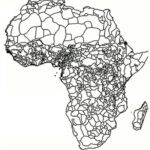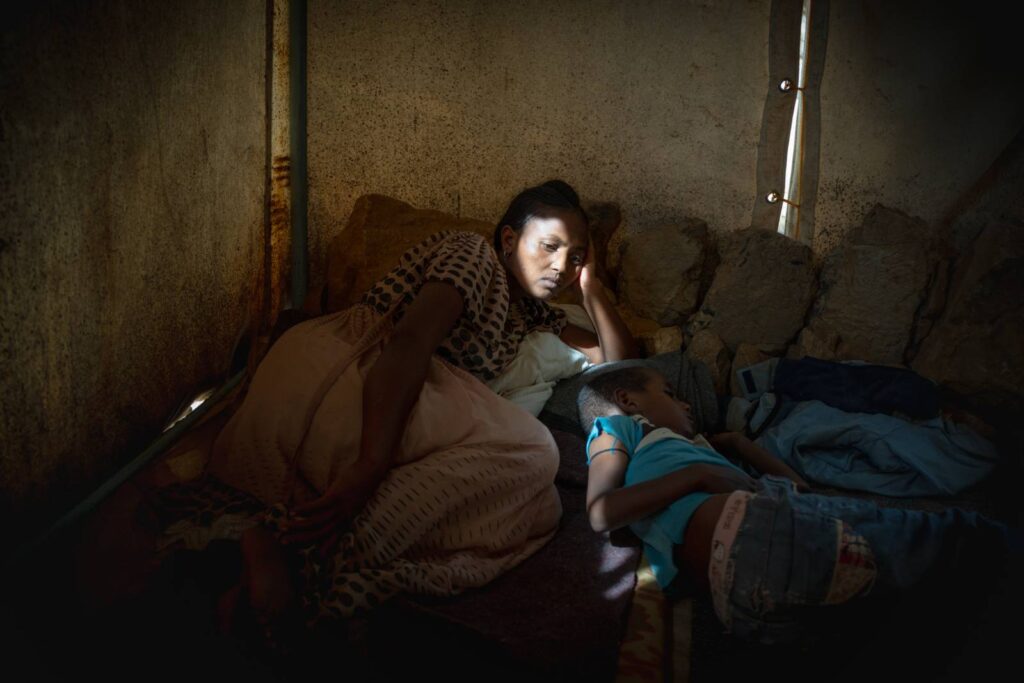By Maya Misikir
Pictures by Petterik Wiggers
Seventeen months since the fighting stopped in Ethiopia’s northern Tigray region, people are still trying to rebuild what was deliberately destroyed – a mammoth task for a population and local government left destitute by the two-year conflict.
Every facet of life in the region – from jobs, to social services, to security – has been impacted by the scorched-earth war, in which as many as 600,000 people may have been killed. It ended with an African Union-brokered peace agreement in November 2022, but the bill for reconstruction has been calculated at $20 billion.
The climate has also taken its toll in Tigray. A drought – the worst in 40 years – followed by a locust invasion, has reduced this year’s expected harvest by half. More than 4.5 million people will need food aid and over one million people are still displaced – crowded into makeshift camps in towns across the region.
Last week, a UN-backed donor pledging conference raised $630 million for Ethiopia, falling well short of the $1 billion needed to provide life-saving support to approximately 11 million people in the northern highlands just for the next five months.
The country’s overarching $3.24 billion humanitarian response plan, targeting 15 million Ethiopians in need, is currently only 5% funded – a sign that an already underfinanced aid operation will continue to struggle this year.
The federal government has also committed $250 million for food support, but the depressing reality is that for a third consecutive year, hunger and acute malnutrition will outpace the scale of relief assistance to famine-threatened regions like Tigray.
The cost of the war
For three decades, Tigray was the political home of the Tigray People’s Liberation Front (TPLF), the main party in the ruling Ethiopian People’s Revolutionary Democratic Front (EPRDF) coalition, until it was dissolved by Prime Minister Abiy Ahmed in 2019.
Under the EPRDF, Tigray benefited from government and aid agency investment. Much of that funding was aimed at improving the resilience of subsistence farmers in the drought-prone region, and led to a proliferation of micro dams, irrigation schemes, and successful conservation-based agricultural initiatives. Two years of conflict have reversed those development gains.
Across Tigray, irrigation infrastructure was destroyed or looted by federal forces, and their Eritrean allies. Trees that took years to grow – and are key to retaining soil moisture and health – were cut down and used for fuel by displaced people and soldiers alike.
With farmers forced to start from scratch, their investments in land and livestock lost, last year’s drought could not have come at a worse time. The poor rains, compounded by an eight-month aid freeze, triggered hundreds of hunger-related deaths.
New initiatives, however, are now underway to get people back on their feet. The rural town of Idaga Hamus, in Tigray’s Central Zone – one of the worst drought-hit areas – is just one location where irrigation schemes are being rebuilt.
In a project supported by the aid agency Save the Children, 11,000 farmers are being provided with irrigation pumps and seeds that have created pockets of flowering and cash-earning mango and orange trees along the banks of the Tsediya river.
Although a start, the scale of needs are daunting. “We have restarted farming, but we are sharing one pump with 15 other families,” 38-year-old Hiwot Kebede told The New Humanitarian. “The land gets dry before it’s our turn to use it again.”
So many needs
While agriculture is a big part of the equation in the region’s recovery, a recent assessment by the World Health Organization has sounded the alarm over Tigray’s broken health infrastructure.
The report noted that only 3% of health facilities are fully functional, and there are zero immunisation services running. That not only complicates post-war recovery but also increases the risk of disease outbreaks like cholera.
The small town of Freweyni, an hour’s drive north of the regional capital, Mekelle, is a case in point. Sitting on a strategic corridor, it was fought over by rebel TPLF forces and Eritrean troops, who had used its primary hospital as a billet.
The town’s residents, who fled the fighting in the first few months of the war, returned to empty houses, robbed of even the most basic of household items.
It has only recently started performing operations again, after managing to replace its looted generator. But the new plant provides only enough power to enable quick surgeries like caesarean sections.
The hospital was not the only place to suffer. The town’s residents, who fled the fighting in the first few months of the war, returned to empty houses, robbed of even the most basic of household items.
“There is a very low number of people who are back doing their previous work or running their business,” Atsbeha Girmay, the town’s mayor, told The New Humanitarian. “That’s because the shops they had or the cows they owned have been stolen.”
No going home
Freweyni is also home to around 700 displaced people. “The conditions here for them are not good, but they can’t go back because the areas they come from in west and south Tigray are now enemy territory,” said Atsbeha.
He was referring to disputed areas now under the administration of the neighbouring Amhara region, whose forces fought alongside the federal government. These zones, claimed by the Amhara – Ethiopia’s second-biggest ethnic group – had been formally granted to Tigray in 1995 under the EPRDF.
A report last year by Human Rights Watch accused Amhara authorities and allied Fano militia of forcibly expelling Tigrayans from western Tigray. According to the government-funded Ethiopian Human Rights Commission, those who have also tried to return to their homes in southern Tigray – where Amhara forces have taken over the towns of Raya and Alamata – have also faced arbitrary detention and harassment.
Ethnic Tigrayans, who fear returning to these disputed territories, make up the bulk of the displaced – forced to live in overcrowded displacement centres, or informal makeshift camps, typically set up in school buildings in towns across Tigray.
“It has been over a year since the peace deal was signed and the guns have been silenced, but we are still dying because we don’t have medicine or proper shelter,” said Muna Yesuf, who used to live in the western Tigray town of Setit-Humera, close to the Sudanese border. “We don’t even have money for salt.”
A former businesswoman, she regularly travelled between Sudan and Tigray until her last trip in 2020, when she was trapped by fighting in the western Tigray town of Mai Kadra, where hundreds of ethnic Amharas were stabbed and hacked to death by TPLF forces.
She lives in Sabacare, Mekelle’s largest IDP camp, which was set up as a temporary shelter at the outset of the war but is now a refuge for close to 27,000 people.
Muna, who serves as the representative for displaced women across Tigray, told The New Humanitarian people in Sabacare don’t want handouts – they just want the chance to go home and restart their lives.
But the 2020 peace agreement left the status of western and southern Tigray vague. It committed the federal government to facilitate the return of displaced people and refugees “whenever the security situation permits”, but did not mention the contested territories directly.
Ethiopia has used referenda in the past to settle demarcation problems, and is a mechanism prime minister Abiy has recommended for the two disputed zones. However, that has been opposed by Tigray’s interim administration, which argues that the areas are not secure enough to allow ethnic Tigrayans to return and vote.
Meanwhile, tensions have been building. Clashes last week between TPLF and Amhara forces in Alamata forced over 50,000 people to flee their homes. Most of the displaced are sheltering with the local community in the neighbouring town of Kobo, while others have settled in a nearby industrial site, still under construction, raising protection concerns.
The fighting in Alamata has not only increased humanitarian needs for an already overstretched aid system but has also raised the alarm over the threat the unresolved issue of the disputed territories can pose to Ethiopia’s hard-won peace deal.
This article was first published on the New Humanitarian:

